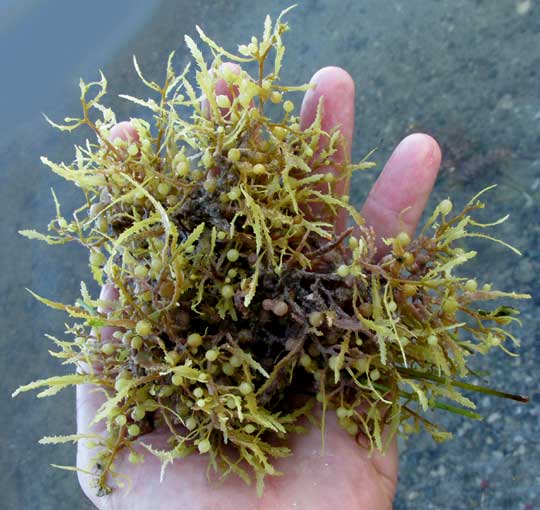Excerpts from Jim Conrad's
Naturalist Newsletter

from the November 16, 2014 Newsletter issued from Río Lagartos, on the Yucatan Peninsula's northern coast (~N21.60°, ~W88.16°), Yucatán state, MÉXICO
NARROWLEAF SARGASSO
In waters of the Ría Lagartos estuary usually you can find clumps of floating alga such as what's shown below:

With no definite stem, this alga branches in all directions and with no obvious pattern. It's free-floating and bears no roots. The spherical, BB-size items are air-filled sacs or bladders enabling the organism to float. A close-up of the alga's bladders and irregularly toothed blade margins is at the top of this page.
In 2011 we profiled a rootless, air-bladder-equipped alga very similar to this washing up on a sandy beach of the Caribbean 20 kms north of Mahahual, Quintana Roo. You can see how similar that species was to our present one at www.backyardnature.net/yucatan/sargasso.htm.
That alga was one of the famous sargasso species, Sargassum fluitans, sometimes called Broadleaf Sargasso. Now here at Río Lagartos I find not only that species but also this second sargasso species, SARGASSUM NATANS, sometimes known as Narrowleaf Sargasso or Narrowleaf Gulfweed. Narrowleaf Sargasso is distinguished from our previous sargasso not only by its narrower leaves, but also by its air bladders being topped by tiny projections that sometimes are spine-like and sometimes branched.
Sargasso is "famous" because it has a whole sea named after it, the Sargasso Sea, a region in the Northern Atlantic Ocean about 1100kms wide (700mi) and 3200kms long (2000mi). The Sargasso Sea forms in the center of a vast, clockwise-turning system of ocean currents -- a "gyre." The whole system is referred to as the North Atlantic Gyre, and nowadays the Sargasso Sea coincides with what's also known as the North Atlantic Garbage Patch. Similar gyres with similar collections of trash and floating vegetation occur in other oceans.
Sargasso is a "brown algae" belonging to the class Phaeophyceae, in the order Fucales. It's distributed in oceans worldwide, generally in shallow water and coral reefs. Around Río Lagartos we don't have coral reefs, but the Gulf of Mexico across the barrier island north of town provides plenty of shallow water.
Floating sargassum makes a good hiding place for tiny animals trying to avoid larger animals who might eat them. European and American Eels meet in the Sargasso Sea to lay their eggs in sargassum. The hatched young then make their ways to their respective continents. It's also thought that after hatching, young Loggerhead Sea Turtles travel in currents such as the Gulf Stream to the Sargasso Sea, where sargassum provides cover from predation until they are larger and can travel the seas.
Sometimes enormous masses of sargasso blow onto beaches that homeowners like to keep clean, and the decaying alga can smell bad. In the past people knew to collect the sargassum to compost and mix with their soil to improve the soil. A 2010 article by Williams and Feagin in Envirorn Manage magazine -- Nov;46(5) -- reported that "... sargassum can increase soil nutrients and produce increased growth in dune plants" and thus should be used by those trying to stabilize sand beaches by establishing plantings. "Beach raking" by neatness-minded landowners destabilizes beaches, making them more vulnerable to storm damage.